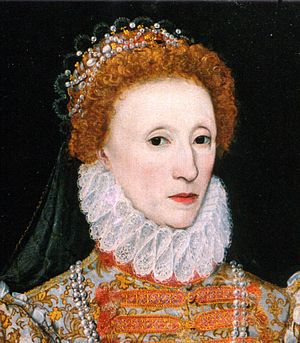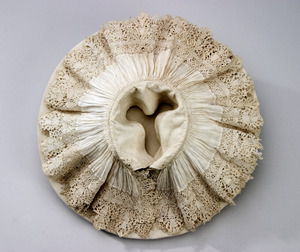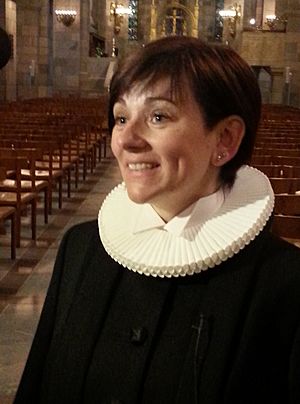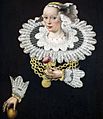Ruff (clothing) facts for kids
A ruff was a fancy collar worn around the neck in Europe and Spanish America from the mid-1500s to the mid-1600s. Some ruffs were very round and flat, like the large stones used in a millstone to grind grain. Because of this, they were sometimes called millstone collars.

Contents
How Ruffs Became Popular
Ruffs were worn by men, women, and children. They started as small, ruffled edges on shirts or dresses. People liked ruffs because they could be taken off and washed separately. This helped keep the main clothes, like a doublet or gown, clean around the neck.
Ruffs were often very stiff, which made people stand up straight. Because they were not very practical for everyday work, they became a sign of wealth and high social status. Only rich people could afford them and the time it took to care for them.
Materials and Making Ruffs
Most ruffs were made from fine linen fabric called cambric. To make them stiff and hold their shape, people used starch. This starch was often brought in from places like the Low Countries (modern-day Netherlands and Belgium). Later, some ruffs were made entirely from lace, which was a very expensive and fancy material at the time.
Over time, ruffs grew bigger and bigger. In 1565, Elizabeth I of England had a ruff that needed about 10 yards of fabric! As starch became more common, ruffs could be made even wider without losing their shape.
Ruffs were separate pieces of clothing. After washing, they were starched and then carefully shaped into fancy folds, often like a figure-eight. This was done using heated, cone-shaped tools called goffering irons. The biggest ruffs, sometimes called "cartwheel ruffs," could be a foot or more wide! These huge ruffs needed a special wire frame called a supportasse or underpropper to hold them up.
When Ruffs Went Out of Style
By the early 1600s, ruffs started to go out of fashion in Western Europe. People began to prefer different styles, like wing collars and falling bands. However, ruffs stayed popular for a longer time in the Dutch Republic and in Eastern Europe. You can see them in many portraits from the 1600s in these areas.
Ruffs also remained part of the official clothing for city leaders in cities like those in the Hanseatic league. They were also worn by Lutheran church leaders in countries like Denmark, Norway, the Faroe Islands, Iceland, and Greenland.
In 1621, Philip IV of Spain even banned the ruff. This was a way to show that he wanted to change old traditions and reduce the power of the conservative Spanish elite.
Ruffs Today
Today, ruffs are still part of the formal clothes for bishops and ministers in the Church of Denmark and the Church of the Faroe Islands. They usually wear them for church services. The Church of Norway stopped using ruffs for its clergy in 1980, but a few ministers still chose to wear them. Sometimes, young boy singers in Anglican church choirs can also choose to wear ruffs.
Ruff Colours
The most common colour for ruffs was white. But sometimes, the starch used to stiffen the ruff was mixed with dyes. This gave the ruffs soft, pastel colours like pink, light purple, yellow, or green. These colours would wash out when the ruff was cleaned.
- Light purple could come from a dye called cochineal.
- Yellow could come from saffron.
- Pale blue could come from a blue pigment called smalt.
A bluish tint in a ruff was thought to make the wearer's skin look paler, which was considered attractive at the time. However, Elizabeth I did not like blue ruffs. She made a rule that no one should wear blue starch because blue was the colour of Scotland's flag, and there were political tensions between England and Scotland.
Of all the dyed ruffs, yellow ones were the most popular across Europe. In England, yellow ruffs became unpopular after a woman named Anna Turner was found guilty of murder. She was known for inventing yellow starch. After her trial, yellow ruffs were sometimes seen as a sign of bad behaviour.
Coloured ruffs are not often seen in old portraits. This is partly because they were less common than white ruffs. Also, later artists who restored the paintings sometimes repainted coloured ruffs as white, thinking that white was the "correct" colour.
Images for kids
-
Philip III of Spain around 1615
-
The wife of the mayor of Lübeck, 1642
-
Itō Mancio, 1585
-
Pedro II of Brazil, 1872
See also
 In Spanish: Lechuguilla (indumentaria) para niños
In Spanish: Lechuguilla (indumentaria) para niños
- 1550–1600 in Western European fashion
- 1600–1650 in Western European fashion
- Piccadill, a similar clothing fashion
- Collar (clothing)















